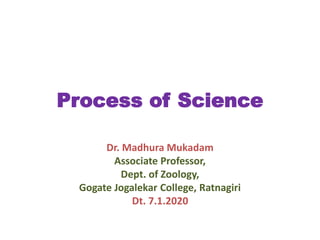
Process of science.pptx
- 1. Process of Science Dr. Madhura Mukadam Associate Professor, Dept. of Zoology, Gogate Jogalekar College, Ratnagiri Dt. 7.1.2020
- 2. • Science is methodical and it aims to give precise knowledge and is a mode of thinking which paves the way for systematic investigation of natural world. • Any person who peruses the process of science systematically is considered as “ Scientist”. • In science ideas are tested and based on the findings they are accepted or rejected or modified.
- 4. 6 Steps to the Scientific Method • 1. Make an observation • 2. Form a hypothesis • 3. Test the hypothesis • 4. Collect, Organize and Analyze the Data • 5. Draw Conclusions • 6. Communicate the results
- 5. Step 1: Observations • Observations based on senses or tools – Sight, Smell, Touch etc. • Observations of natural events usually raise a question – Why did the water rise when the candle went out? – Research is usually done to help find out more about the question raised
- 6. Step 2: Form A Hypothesis • Based on your observation a Hypothesis is formed that tries to explain your observation or answer your question – A hypothesis tries to predict or determine the outcome of your experiment even before the experiment is done • Predictions usually stated in an “if ….. Then” statement. Ex: If I drop a rock then it will fall down toward the ground • HYPOTHESIS MUST BE TESTABLE!
- 7. Step 3: Test the Hypothesis • Controlled Experiments are used to test a hypothesis – A controlled experiment is an experiment that tests only one factor at a time by – a control group is compared with an experimental group. Variables are not changed in the Control Group. – Control groups allows you to see if a change in a variable creates an observed outcome by comparing the control group with the exp gp – A variable is a factor that changes in a controlled experiment. Variables are changed in the Exp Group AND SERVE AS THE FACTOR TESTED
- 8. VARIABLES • INDEPENDENT – The variable being changed in the experiment • DEPENDENT – The variable that responds to the changed independent variable – The variable being measured • EX: growing plants with different amounts of fertilizer
- 9. Step 3 Continued • Scientists try to design experiments that will clearly show whether a particular VARIABLE caused an observed outcome • IF IT CANNOT BE OBSERVED THEN IT CANNOT BE TESTED!!! – Can we test if a comet impact kill the dinosaurs? Why or Why Not? • Sometimes models are used to represent a real object – Used when it is difficult to control all of the variables or not possible to test “the real thing”
- 10. Step 4: Collect, Organize & Analyze Data • Data collected from experiments – Data is defined as: recorded observations or measurements (qualitative = description, quantitative = number data) – Based on observations – Utilize tools or senses: sight, smell, temperature change etc. • Data is organized in tables, charts and graphs so that it can be more easily analyzed
- 11. Step 5: Draw Conclusions • Scientists decide whether the results of the experiment support a hypothesis. • When the hypothesis is not supported by the tests the scientist must find another explanation for what they have observed – NO EXPERIMENT IS A FAILURE: All experiments are observations of real events
- 12. Step 6: Communicate the Results • Results must be communicated in the form of a written paper or presentation • Communication helps other scientists performing the same experiments to see if the results of your experiment are the same as their results – Helps people see if results are repeatable!
- 30. Theories • Theories are explanations for some phenomena based on observation, experimentation, and reasoning. – BASED ON MANY EXPERIMENTS – Experiments that explain a theory MUST be repeatable – You must be able to predict from a theory
- 31. LAWS • Laws are summaries of many experimental results and observations • Laws are not the same as theories because laws tell only what happens, not why it happens.
- 32. Pure Science • PURE SCIENCE • Pure Science: An attempt to learn more about the world or the continuing search for scientific knowledge. • pure science is done by scientists or people with inquisitive minds • involves experimentation, observations, questioning and research • involves technology
- 33. Technology • Technology: An application of science to meet the needs of society • engineers, inventors and creative people apply scientific knowledge to build new “things” or tools • new technology can lead to new scientific discoveries – ex: we could not learn about cells before the invention of the microscope • Question: How does science lead to new technology and how does technology add to our scientific understanding of the natural world?